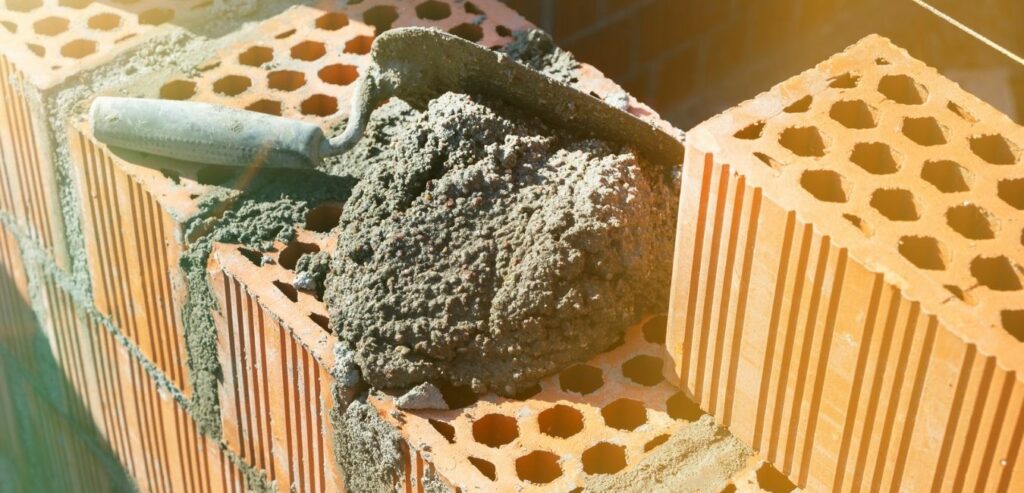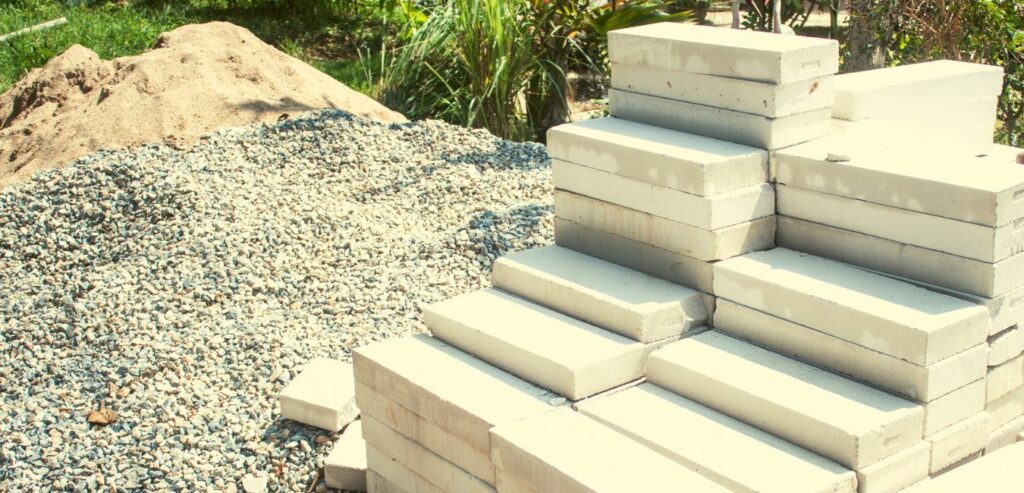A construction building material is any substance used in building a structure. There are various kinds of materials used for building in the construction industry. We use different materials depending on their structural capabilities. In different regions, local and national standards govern building materials in construction. On the other hand, Architects choose construction materials based on aesthetics and cost. Picking the suitable material for your project means enhancing and lengthening a project’s lifetime. Some of the most common construction materials are as discussed below.
Table of Contents
1. Concrete
Concrete is one of the most common construction materials. It is a composite material from fine and coarse aggregate mixed with a binder like cement and water. The mixture is then left to cure and set over time. Concrete takes seven days to cure and an average of 28 days to attain maximum strength. Reinforced concrete is most common in construction, whereby steel is embedded in the concrete to increase the structural tensile strength. Concrete comes in many forms, with examples such as lightweight concrete and waterproof concrete. The project type dictates the type of concrete used. One of the most significant advantages of concrete is that it can be poured into any shape and hardened into a stone-like material.
Because of its cost and versatility, concrete is a common material in construction. We use concrete for:
- Foundations
- Residential building construction
- Commercial building construction
- Bridge construction
- Culverts and sewers.

2. Steel
The construction of skyscrapers exploded from our discovery of steel as a reinforcement material. Steel is a composite material made from alloys of iron and carbon. Steel has high strength and functionality. It is also lightweight, easy to work with, and cheaper to ship than other building materials. Steel does not easily deform unless we place a tremendous amount of weight on it, and it retains its structural properties even when it is bent. Due to its structural stability, we use steel to make tall modern buildings’ structural frameworks.
Steel has distinguishing qualities such as high strength to weight ratio. It is less time-consuming to install than concrete, and we can install it in any environment. If not correctly installed, however, steel is susceptible to corrosion. One of the significant drawbacks of steel as a construction material is that it is likely to break down during high-temperature levels. Its level of fire resistance depends on the type of steel.
We commonly use steel is in construction for the following purposes:
- For structural sections: We use steel as reinforcing bars to increase the tensile strength of structures.
- Roofing: We use steel to make roofing products such as purlins, internal walls, ceilings, and cladding.
- Internal fixtures: We use it to make interior fittings such as rails and stairs.
- Utilities: We construct underground water, fuel, power, and gas lines using steel.
3. Wood
Wood is arguably the oldest construction material as it has been in use. It is naturally available and cost-efficient, strong and durable, and flexible in all senses. It can be bent, molded, or cured into desirable shapes. Other than its durability, wood is an environmentally sustainable material. We can use wood for commercial and residential buildings, and it works well with other materials. It functionally works well with steel, marble, and aluminum. Compared to other construction materials, wood is relatively light and easy to standardize in size. It has high tensile strength and is good in soundproofing and insulation.
We use wood in construction in the following areas:
- Construction of walls, floors, and ceilings
- Construction of interiors such as door and window frames
- Frames of structures in buildings and bridges
- Thermal insulation
- Acoustic insulation
4. Stone
Stone is the longest-lasting building material. The most ancient buildings in the world are made of stone. We commonly use stone in walls and floorings, and the texture makes it versatile. Stone comes with smooth finish textures to rough ones and also comes in many different colors. Examples of stones used in construction are sandstone, granite, and marble. Ordinary stone is cheap, but the prices go up for unique finishes. For marble countertops, quality and color increase the production time and cost.
Stone has a few drawbacks. Its density affects its workability due to its weight, thus making it difficult to move it. Stone is also a terrible insulator therefore ineffective for insulation in cold environments.
We use stone in construction in the following aspects:
- As rough aggregate in construction
- In masonry works for walls, dams, and bridge piers
- As ballast for railways
- For damp proofing of external walls
- Stones like marble are used for making excellent polish finishes.

5. Brick/Masonry
Masonry uses bricks which are rectangular blocks, and they are later bound with mortar. Bricks were traditionally made from heated and dry clay. They have a high compression resistance, but they can break easily. The most vital bricks in existence now are concrete blocks which are reinforced using steel. Masonry is fire-resistant and durable. Due to its high compressive strength, we use it to construct load-bearing walls. Masonry can support multi-story buildings when reinforced with concrete, thus providing an economical building choice.
Masonry is used in various construction components such as:
- Used for walls
- Used for masonry foundations
- Other types, such as veneer masonry, are used for decorating finishes.
- Masonry is also used for gabion construction in flood-prone areas.
Other construction materials
Other popular construction materials include:
- Bamboo
It can also create planks and sheets for flooring, carpentry, and furniture.
- Construction foam
Bamboo is a unique material with a high strength-to-weight ratio. It rivals concrete, brick, and wood in terms of compressive strength and high tensile strength. It is mostly applied in residential buildings, scaffolding, and bridges.
This plastic foam material is used in buildings to curtail air infiltration and provide thermal insulation. Some common forms of concrete foam include polystyrene and polyurethane foam inserted between cement, wood, and other concrete forms.
- Glass
Glass is made from liquid sand and is used in most buildings to construct facades. It is also used for flooring and internal building partitions. Glass has a lower weight than brick and masonry and has a better aesthetic appearance.
The thickness of the glass is selected according to the applied loads and is designed to comply with the design standards.
- Aluminum
Aluminum is increasing in demand, especially with the scarcity of timber in construction. It is an eco-friendly material with a minimal effect on the ecosystem compared to other construction materials.
Aluminum is not as strong and is mixed with other alloys like copper and magnesium to increase its strength. Different aluminum grades have different strengths, and the selection of the material depends on its application.
The importance of selecting the correct materials
Material selection is fundamental in any building project or renovation. Though most contractors already have a contract sum in mind, it is best to consider the suitability of materials in a project despite the cost. Below are some of the importance of selecting the right materials in a construction project.
- The durability of the material
The durability of a material affects the defects liability period and the timeframe of warranty within the project. It is also best to ensure the durability of construction materials to ensure the stability of a structure. Durable construction materials won’t need frequent repairs and replacements; therefore, one can distribute the raw materials, and environmental and energy impacts over time.
Sometimes buildings are modified for reasons that do not concern their structural integrity, and durability planning maps out a reasonable service life target of a building.
- Cost of materials
The cost of materials is a vital discussion point between engineers, the client, and the architect. However, looking for the most affordable product without considering its lifespan and utility is not always desirable.
Correct building materials will serve you long-term and be more cost-effective in your project.
- Environmental impact of a material
The choice of construction materials is primarily made on cost, structural, and thermal properties. However, building materials have environmental implications, such as pollution and energy consequences in the manufacturing processes.
Poor quality construction materials also increase waste issues throughout the stages of construction. Construction materials affect the lifecycle and recycling options during a project’s expected life.
If you have the option to select an ecologically friendly material that doesn’t sacrifice quality, it is encouraged to apply it.
- Better adherence to project milestones
Improper selection of materials can affect your material management system and sequence of construction activities. Quality materials will minimize the required repairs and make it possible to deliver a project within the stipulated timelines.
FAQs
Below are the answers to the frequently asked questions concerning construction materials.
What is the most durable building material?
Stone is the most durable building material. It is fire resistant and does not rot, therefore lasting over very long periods.
Which metal is used in construction?
The most common metal used in construction is steel; however, other metals such as aluminum. Copper, iron, and steel are also used for different construction aspects.
Summary
The use of different materials in construction enhances and strengthens the finished job. The construction industry is rapidly growing, and so are the building materials. There are, therefore, many modern construction materials adopted to make a project successful. Construction planners need to analyze their choice of building materials to find which material works best during a project’s planning phase. Suppliers also play a vital role in the quality of materials, and you should choose a good supplier and work with them for the timely delivery of your materials.

